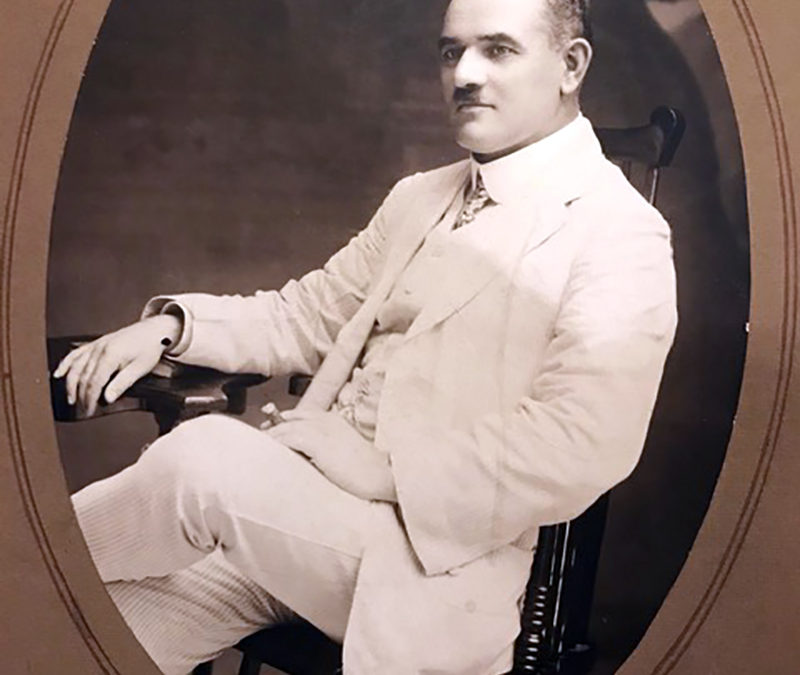My great grandfather, Captain Frederick Lincoln Adamson, wearing a suit. Early 20th Century. Possibly taken in India on service in the merchant Navy. Or possibly in Yorkshire. Either way, nice use of a casual cigar in the shot.
Recently I got rid of almost all my suits. As a 42-year-old white guy who went to private school in England it was a big move. The only suit I’ve got left, in fact, is the baby-blue suit I got married in, and which I wore for Freddy’s christening.
Every single time I put a suit on for work, it made me feel bad about myself. I had flashbacks to school rules. I realized the implicit message was: “I’m prepared to compromise on most things I think are important, to earn money.”
Maybe it’s the world of tech funding where the richer you are the worse you dress. Maybe it was Mad Men. Maybe the last straw was the Donald. But: People no longer trust guys in suits. When I’m not wearing a suit, I’m a keen follower of fashion. I like to wear clothes that communicate a certain message. From Todd Snyder t-shirts to L.L.Bean collaborations and “selvedge” denim, I like to wear clothes that say: “I’m excited by the possibilities in life, and I promise not to be a jerk if I can help it.” Also: Fit matters.
But wearing a suit always feels like one-up-man-ship, to me. It’s like saying, “yes, I’m here, and you’re here, but we both know I’m wearing the winning uniform.”
It doesn’t seem fair.
Jude Law is advertising suits with his son, lately. I still can’t get into them. To me, wearing a suit is about hiding who I am and what I value about myself. In the world of cause-driven work, that’s a bad look. Particularly when you’ve benefited from as many advantages as I have.
More and more funders are realizing these days, “we look too much like the people we’re supposed to be standing up to.” And thanks to the huge growth in new funding for nonprofits, the sector is changing. I want to be part of that change, not a hold-out. Here’s something inspiring from consultant Hali Lee’s worth-a-read report about donors of color, called Philanthropy Always Sounds Like Someone Else: A Portrait of High Net Worth Donors of Color:
The context is philanthropy in the US, which has historically been a white story, a male story, sometimes a dead white male story, and recently a billionaire’s story.
The assumption has been that BIPOC folks don’t have the resources to be major donors. The truth is exactly the opposite. We’ve always been there, we’ve just been apparitional, unseen.
Unseen. That triggered a parallel thought. White men don’t talk much about our clothing choices, particularly not at work. But I’m fascinated in why that is. There’s a sort of invisibility cloak there, and it’s about power. We should be striving to throw it off.
I had a great conversation about wearing a suit with another philanthropic consultant. I was trying to figure out if I should do it to avoid scaring off more clients at a certain level. The multi-billion-dollar foundations look a little different from the grassroots nonprofits. She was direct.
“Don’t do it,” she said. “There are far too many white guys in suits working in philanthropy already. You’re not going to find it as easy to get in the door in the first place. But you’ll find the people who like you. And they’ll like you for you.”
Something I find a lot is that foundations say they want to think differently. But it’s worth testing their commitment to originality early and often.
Also, she said, it was important to remember that I didn’t want to earn money in a way that makes me feel bad about myself. I laughed. It went against one of the implicit things I’ve learned in working life. In other words, I’ve learned that work should be miserable! My grandad wore a chauffeur’s suit to drive tractor executives around. His father wore a captain’s uniform on board his naval ships and white linen suits on shore. Neither of them enjoyed work. My granddad used to take his watch off and put it on the mantlepiece when he get home as if to say, “my time is my own, now.” I admire the ability to compartmentalize. But I don’t want to emulate it. I’m lucky not to have to. Part of that luck is about having the confidence to turn down the work that disagrees with me.
My favorite thing to wear is a pair of Adidas Stan Smith trainers with Kermit the frog on them. I got them after seeing a woman in them on the subway. They say “it’s not easy being green” on the back. I get compliments on them most days, walking around New York. I even saw Jake Gyllenhaal had got himself a pair on Instagram. So, that’s validation.
Would I have the guts to wear them to a client meeting? I’d like to think so. The other week I went to my first in-person event in a couple of years. I showed up in a denim jacket and green cords with a Goorin Brothers hat on. I couldn’t stand the idea of showing up like a politician’s body-man. If we’re trying to change the idea of what power looks like, then men have a big role to play.
I’m a work in progress, to paraphrase Will Smith’s recent apology to the Oscars board. I’m grateful the pandemic has shaken up what it means to go to work. I’m grateful I don’t have to commute to midtown Manhattan daily. I also feel bad for the people who do. On 39th street and Sixth Avenue it’s scarier to wear the Kermit trainers than it is to wear a suit. It’s the biggest sign that I’m thinking along the right lines.
A big part of this is about society’s evolving view of gender, too. How much it is constructed and modeled in our communication based on what we choose to wear. My friend and occasional colleague Ellen said to me on Monday, “suits are drag,” and I’ve been thinking about that, too. The English cross-dressing artist Grayson Perry made a fabulous TV show about masculinity that made me think hard about the guts it takes for him to put a dress on. Muslim Pakistani-British comedian Mawaan Rizwaan wears acrylic nails in the new series of Taskmaster and I kept thinking, “Wow. That guy has some guts.” My hairdresser also told me she wears a suit sometimes to escape the expectations she’s experienced her whole life around what she’s supposed to wear. I’m very happy for her to have the same experience I have, ditching a suit, by wearing hers. It’s finally a relief to break free from a lot of the ideology I took on at school. Here’s to “unlearning” many of the less healthy things we’ve taken on without realizing. Suits included.


